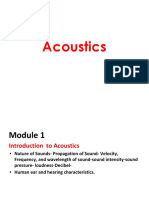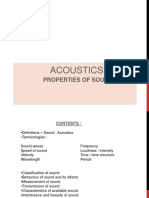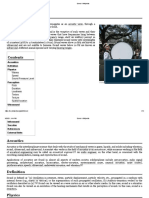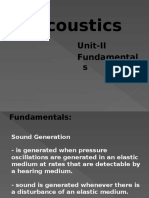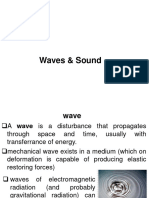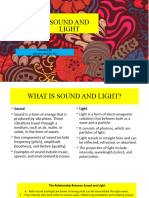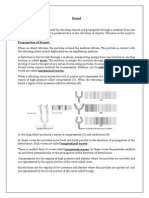0 ratings0% found this document useful (0 votes)
5 viewsSection One:-Sound Waves Section Two:-Sound Intensity and Resonance
Section One:-Sound Waves Section Two:-Sound Intensity and Resonance
Uploaded by
abdallah.civilengineeringCopyright:
© All Rights Reserved
Available Formats
Download as PDF, TXT or read online from Scribd
Section One:-Sound Waves Section Two:-Sound Intensity and Resonance
Section One:-Sound Waves Section Two:-Sound Intensity and Resonance
Uploaded by
abdallah.civilengineering0 ratings0% found this document useful (0 votes)
5 views12 pagesOriginal Title
1025908763
Copyright
© © All Rights Reserved
Available Formats
PDF, TXT or read online from Scribd
Share this document
Did you find this document useful?
Is this content inappropriate?
Copyright:
© All Rights Reserved
Available Formats
Download as PDF, TXT or read online from Scribd
Download as pdf or txt
0 ratings0% found this document useful (0 votes)
5 views12 pagesSection One:-Sound Waves Section Two:-Sound Intensity and Resonance
Section One:-Sound Waves Section Two:-Sound Intensity and Resonance
Uploaded by
abdallah.civilengineeringCopyright:
© All Rights Reserved
Available Formats
Download as PDF, TXT or read online from Scribd
Download as pdf or txt
You are on page 1of 12
Sound
Chapter 12
Section one :-Sound Waves
Section two :- Sound Intensity and Resonance
Section one
Sound Waves
WHAT IS SOUND WAVES?
sound is a vibration that propagates as an acoustic wave, through a transmission
medium such as a gas, liquid or solid.
Sound can propagate through a medium such as air, water and solids as longitudinal
waves and also as a transverse wave in solids .
• In air, the vibrations of air molecules are parallel to the direction of wave motion ,region
of high molecular density and high air pressure is called a compression.
• the molecules to the right spread apart, and the density and air pressure in this region
become lower than normal. This region is called a rarefaction.
• The speed of sound depend on the kind of medium, also depends on the temperature
of the medium. As temperature rises, the particles of a gas collide more frequently.
CHARACTERISTICS OF SOUND WAVES
sound waves that the average human ear can hear, called audible sound
waves, have frequencies between 20 and 20 000 Hz. (An individual’s hearing
depends on a variety of factors, including age and experiences with loud noises.)
Sound waves with frequencies less than 20 Hz are called infrasonic waves,
and those above 20 000 Hz are called ultrasonic waves.
Frequency determines pitch, where pitch a measure of how high or low a sound is
perceived to be, depending on the frequency of the sound wave.
As the frequency of a sound wave increases, the pitch rises.
SOUND WAVES PROPAGATE
the sound waves spread out in all directions. The wave fronts of sound waves spreading in
three dimensions are approximately spherical. The circles represent the centers of
compressions, called wave fronts, the distance between adjacent wave fronts is equal to one
wavelength, λ.
The radial lines perpendicular to the wave fronts are called rays. The sine curve corresponds
to a single ray. Because crests of the sine curve represent compressions.
DOPPLER EFFECT
Doppler effect an observed change in frequency when there is relative motion between
the source of waves and an observer.
the frequency of the source remains constant, the wave fronts reach an observer in front of
the ambulance (Observer A) more often than they would if the ambulance were stationary.
the wave fronts reach an observer behind the ambulance
(Observer B) less often than they would if the ambulance were stationary.
As a result, the frequency heard by Observer B is less than the source
frequency
Section two
Sound Intensity
and Resonance
SOUND INTENSITY
Intensity the rate at which energy flows through a unit area perpendicular to the direction
of wave motion.
As the sound waves travel outward from the source, energy is transferred from
one air molecule to the next. The rate at which this energy is transferred
through a unit area of the plane wave is called the intensity of wave.
the power emitted by the source (P) is
distributed over a spherical surface (𝐴𝑟𝑒𝑎 = 4𝜋𝑟 2 )
HOMEWORK
PAGE 415
INTENSITY AND FREQUENCY DETERMINE WHICH SOUNDS
ARE AUDIBLE
.Intensity is also a factor in determining which sound waves are audible. sounds at
low frequencies (those below 50 Hz) or high frequencies (those above 12 000 Hz)
must be relatively intense to be heard, whereas sounds in the middle of the
spectrum are audible at lower intensities. The softest sounds that can be heard by
the average human ear occur at a frequency of about 1000 Hz and an intensity of
10x10−12 W/m2.
The loudest sounds that the human ear can tolerate have an intensity of about 1.0
W/m2. This is known as the threshold of pain because sounds with
greater intensities can produce pain in addition to hearing
You might also like
- River DiversionDocument57 pagesRiver DiversionAzaz Ahmed100% (4)
- Physics: Lect. No. 6 "Sound Waves"Document14 pagesPhysics: Lect. No. 6 "Sound Waves"Nawras aliNo ratings yet
- Acoustics - Module 1Document40 pagesAcoustics - Module 1Ashna AshrafNo ratings yet
- Theory of AcousticsDocument51 pagesTheory of AcousticsVeda DeshpandeNo ratings yet
- Sound: Norazura BT Mizal AzzmiDocument58 pagesSound: Norazura BT Mizal AzzmiWan Mohd SayutiNo ratings yet
- Sound Waves - An EssayDocument8 pagesSound Waves - An EssayAshley RoyNo ratings yet
- Acoustics PDFDocument28 pagesAcoustics PDFCharles Harvey Cabrezos DaabayNo ratings yet
- Unit 2 PDFDocument38 pagesUnit 2 PDFyashaswiniNo ratings yet
- Physics 10Document13 pagesPhysics 10dashalka96No ratings yet
- BU3 Acoustics PDFDocument257 pagesBU3 Acoustics PDFeyo rimasNo ratings yet
- Physics Project 1Document14 pagesPhysics Project 1Khadeeja RushinNo ratings yet
- Chapter 11 Sound PDFDocument30 pagesChapter 11 Sound PDFtirupativyasNo ratings yet
- Acoustics Module 1Document33 pagesAcoustics Module 1mariyaNo ratings yet
- Chapter 1 - Wave (Form 5)Document29 pagesChapter 1 - Wave (Form 5)kcnjojo91% (11)
- Longitudinal WaveDocument5 pagesLongitudinal WaveChristineNo ratings yet
- Unit 2Document38 pagesUnit 2saahasitha 14No ratings yet
- Building Utilities 3: Lecture 1 - Waves and Sound WavesDocument120 pagesBuilding Utilities 3: Lecture 1 - Waves and Sound WavesJann BayotNo ratings yet
- Sound EnergyDocument7 pagesSound EnergysaibapritulNo ratings yet
- Sound Waves MYP4Document9 pagesSound Waves MYP4ehan.ilrnestersNo ratings yet
- Sound WavesDocument17 pagesSound WavesgeethuNo ratings yet
- Ultrasound Techniques-1Document62 pagesUltrasound Techniques-1yahyaNo ratings yet
- Aliwatya LamashaDocument4 pagesAliwatya LamashaRemison YokoNo ratings yet
- Chapter Sound Notes Class 9Document4 pagesChapter Sound Notes Class 9dhruvi.srivastavaNo ratings yet
- SoundDocument28 pagesSoundKunal100% (1)
- Sound WavesDocument8 pagesSound WavesAliyu MuhammadNo ratings yet
- General NotesDocument19 pagesGeneral NotesAhmedBIowarNo ratings yet
- Is A Sound, Especially One That Is Loud or Unpleasant or That Causes DisturbanceDocument10 pagesIs A Sound, Especially One That Is Loud or Unpleasant or That Causes DisturbanceRajnish AnandNo ratings yet
- Sound: Perception by The BrainDocument13 pagesSound: Perception by The BrainArjunNo ratings yet
- Introduction of Ultrasound Imaging: Sudeepta Maiti 211142001 MSC MitDocument30 pagesIntroduction of Ultrasound Imaging: Sudeepta Maiti 211142001 MSC Mitjacobabraham3471No ratings yet
- Ch.12SoundDocument12 pagesCh.12Soundprasannagg30No ratings yet
- Chapter 3 SOUNDDocument18 pagesChapter 3 SOUNDGaliasis Akoualefo nkefackNo ratings yet
- SoundDocument12 pagesSoundbreshnaimran321No ratings yet
- Propagation-of-Sound-Waves 2Document4 pagesPropagation-of-Sound-Waves 2Piyush RoyNo ratings yet
- 2021 BUILDING UTILITIES 3 - Module 1 Lecture 1 Waves and Sound Waves (S)Document34 pages2021 BUILDING UTILITIES 3 - Module 1 Lecture 1 Waves and Sound Waves (S)Sophia Manila SillaNo ratings yet
- 2022 WTS 12 Doppler EffectDocument26 pages2022 WTS 12 Doppler Effectcebelihlempontshane446No ratings yet
- Unit 02-Lecture 03Document6 pagesUnit 02-Lecture 03Harshan SNo ratings yet
- Acoustics: Unit-II Fundamental SDocument38 pagesAcoustics: Unit-II Fundamental SyashaswiniNo ratings yet
- SoundDocument13 pagesSoundaligoda9887No ratings yet
- 2020 Wts 12 Doppler Effect 1Document22 pages2020 Wts 12 Doppler Effect 1solaniimanikortezNo ratings yet
- Assignment 1 Behaviour of Sound: Submitted by Chitra Rana 5 TH SemDocument18 pagesAssignment 1 Behaviour of Sound: Submitted by Chitra Rana 5 TH SemPrateekNo ratings yet
- Unit IDocument82 pagesUnit INisarga JNo ratings yet
- Unit VDocument460 pagesUnit VNisarga JNo ratings yet
- CH 12 Sound 1Document38 pagesCH 12 Sound 1amitvairagade32351No ratings yet
- Acoustics PPT EMDocument31 pagesAcoustics PPT EM8D cibi chakrawarthyNo ratings yet
- Physics Notes Unit 3: WavesDocument7 pagesPhysics Notes Unit 3: WavessummitgamerzcareNo ratings yet
- 04.3 UNIT - 4 Surface Mining Env - IDocument117 pages04.3 UNIT - 4 Surface Mining Env - Inumendrakumarpandey2003No ratings yet
- Presentation 2Document6 pagesPresentation 2Sudip BiswasNo ratings yet
- SOUNDDocument4 pagesSOUNDHitesh kalraNo ratings yet
- Acoustics BasicsDocument41 pagesAcoustics BasicssebasanctumNo ratings yet
- Architectural Acoustics.Document14 pagesArchitectural Acoustics.maniNo ratings yet
- What Is Sound???Document24 pagesWhat Is Sound???Abhi VallabhaneniNo ratings yet
- Light and Sound WavesDocument12 pagesLight and Sound Wavesmaureen.lumbao95No ratings yet
- Sound What Is Sound?Document6 pagesSound What Is Sound?Ravi Mehroliya100% (2)
- SoundDocument12 pagesSoundshreyashmaurya788No ratings yet
- Unit-4 Acoustic and Ultrasonic WavesDocument29 pagesUnit-4 Acoustic and Ultrasonic WavesSP.TrushadNo ratings yet
- 2017-09-17 Architecture Acoustics (F D Architect's Conflicted Copy)Document69 pages2017-09-17 Architecture Acoustics (F D Architect's Conflicted Copy)HARSHITA JAINNo ratings yet
- Introduction - AcousticDocument22 pagesIntroduction - Acousticpatel shivanginiNo ratings yet
- Sound Theory KMAE Ref MaterialDocument24 pagesSound Theory KMAE Ref Materialvishwa NNo ratings yet
- Physics Quiz ReviewerDocument7 pagesPhysics Quiz ReviewerJennylyn CariagaNo ratings yet
- How Do Waves Behave? How Are They Measured? Physics Lessons for Kids | Children's Physics BooksFrom EverandHow Do Waves Behave? How Are They Measured? Physics Lessons for Kids | Children's Physics BooksNo ratings yet
- Experiences of MAC Student Nurses During Their Clinical DutyDocument4 pagesExperiences of MAC Student Nurses During Their Clinical DutyChombe JcNo ratings yet
- Van Den Bergh 2011 Li 2003: Anatomical MaturationDocument12 pagesVan Den Bergh 2011 Li 2003: Anatomical MaturationTitin Tria UtamiNo ratings yet
- Gulf Synthetic Gear Oil - PAGDocument1 pageGulf Synthetic Gear Oil - PAGatripathi2009No ratings yet
- DU SpectrophotometerDocument9 pagesDU SpectrophotometerAbhishek Azaad MishraNo ratings yet
- PVC LINK Catalogue 2014Document16 pagesPVC LINK Catalogue 2014Siew Choo SoonNo ratings yet
- Vol 2019Document268 pagesVol 2019Arisitica VinilescuNo ratings yet
- 1 s2.0 S0038080621001037 MainDocument17 pages1 s2.0 S0038080621001037 MainFred AgliamNo ratings yet
- 2 Detail of Lab Rubrics For Fluid FinalDocument1 page2 Detail of Lab Rubrics For Fluid Finalirfan ullahNo ratings yet
- Bibliography 1Document4 pagesBibliography 1Himanshu KakkarNo ratings yet
- Colorante, Saborisantes y Blending en USADocument11 pagesColorante, Saborisantes y Blending en USAjosematos01012023No ratings yet
- Kajian Investasi Bisnis Hotel Budget Di Medan: Lokasi Bandara KualanamuDocument10 pagesKajian Investasi Bisnis Hotel Budget Di Medan: Lokasi Bandara KualanamufitrifirdaNo ratings yet
- Gamma Ray LogDocument22 pagesGamma Ray LogNitishNo ratings yet
- Lab Exercises-Developing ToothDocument8 pagesLab Exercises-Developing ToothMonica BalutaNo ratings yet
- The Perceived Effect of Broken Family On The Academic Performance of Junior High School Students at San Luis National High SchoolDocument6 pagesThe Perceived Effect of Broken Family On The Academic Performance of Junior High School Students at San Luis National High SchoolGladysNo ratings yet
- HACCP CertificationDocument5 pagesHACCP CertificationBabu LalNo ratings yet
- Internal Training Traning Conducted By: B.A Mohamed Ibrahim Topic: Safety in LiftingDocument4 pagesInternal Training Traning Conducted By: B.A Mohamed Ibrahim Topic: Safety in LiftingibrahimNo ratings yet
- (LIA1006) Ans ScriptDocument7 pages(LIA1006) Ans ScriptA.r.RajendranNo ratings yet
- 132KV Isolator CatalogDocument3 pages132KV Isolator CatalogTanvir Ahmed Minar0% (1)
- 30xw 1tDocument148 pages30xw 1tMaltin SelmanllariNo ratings yet
- Jonathan K Lab ReportDocument3 pagesJonathan K Lab Reportjonathanko990630No ratings yet
- Intake and Exhaust SystemsDocument16 pagesIntake and Exhaust SystemsBrenzell BarugNo ratings yet
- Examples of Critical Thinking EssaysDocument6 pagesExamples of Critical Thinking Essaysafibaubdfmaebo100% (2)
- Week 5 Bending Non-Metallic ConduitDocument18 pagesWeek 5 Bending Non-Metallic Conduitruth eliezer alcazarNo ratings yet
- ICSE 2017 Chemistry Science Sample Paper 2 PDFDocument7 pagesICSE 2017 Chemistry Science Sample Paper 2 PDFPrabhat BhatNo ratings yet
- Hallux ValgusDocument16 pagesHallux ValgusucssNo ratings yet
- Day 2 Word SearchDocument1 pageDay 2 Word SearchJessie GainsanNo ratings yet
- 02-RLC-Dengue-101-11-04-2022-copyDocument73 pages02-RLC-Dengue-101-11-04-2022-copyRandolph Lampad100% (1)
- Proceedings of XXVIII Meeting of The ICAR National Agricultural Education Accreditation Board (NAEAB)Document9 pagesProceedings of XXVIII Meeting of The ICAR National Agricultural Education Accreditation Board (NAEAB)Shasyendra JB YadavNo ratings yet
- General Anatomy by MuneebUrRehman 1st EditionDocument186 pagesGeneral Anatomy by MuneebUrRehman 1st EditionMuneeb Ur RehmanNo ratings yet


